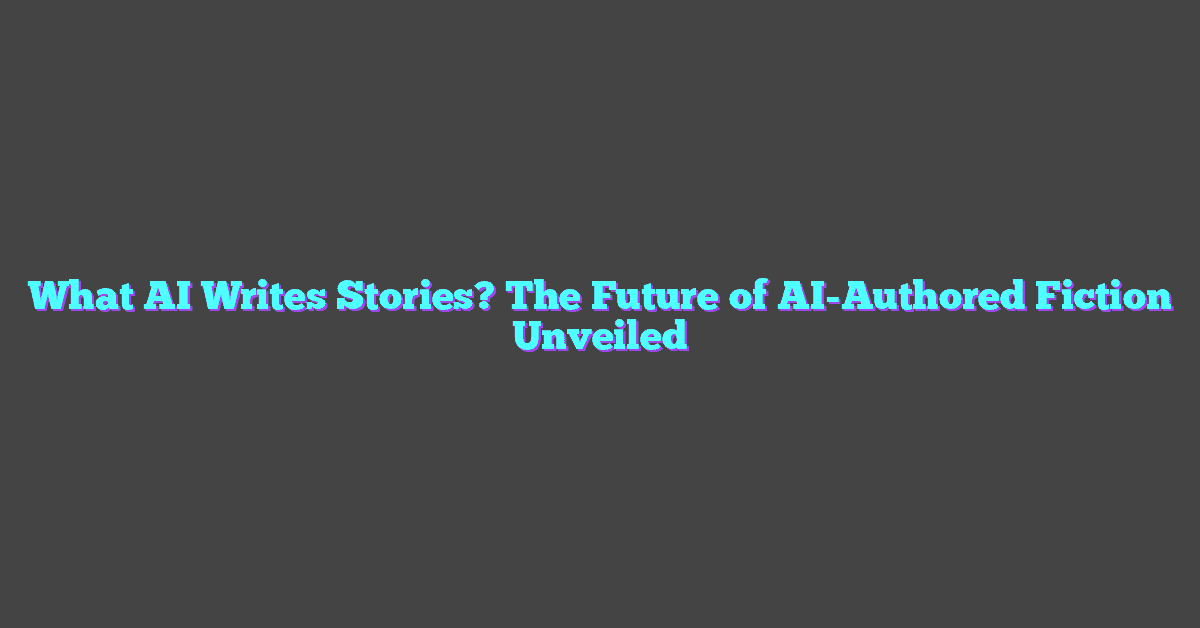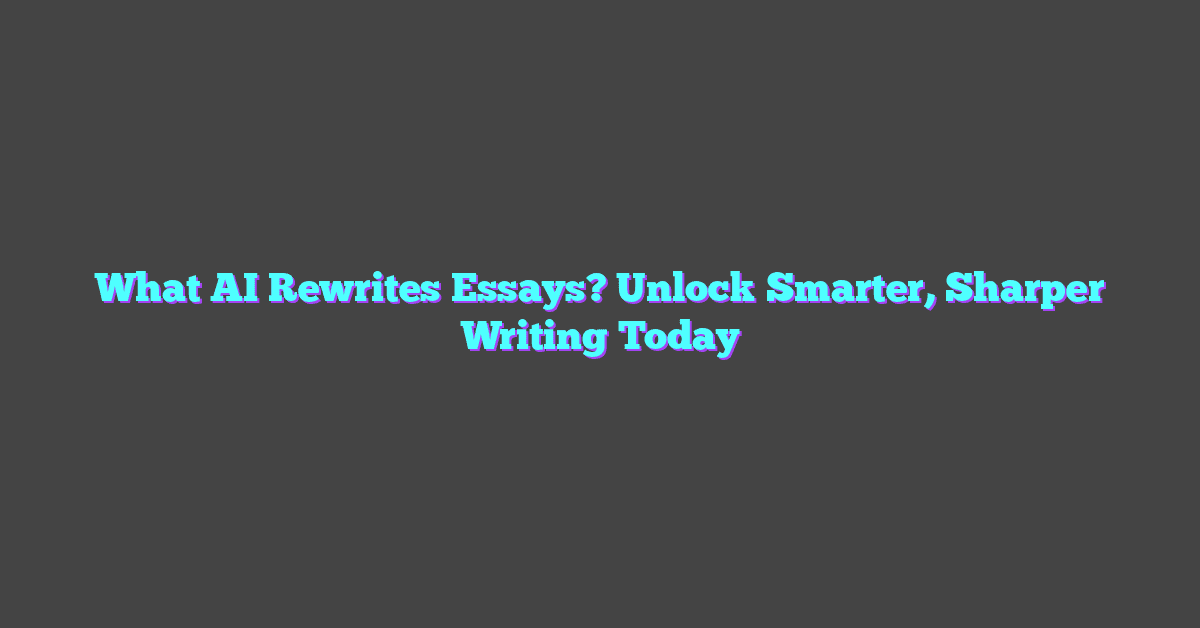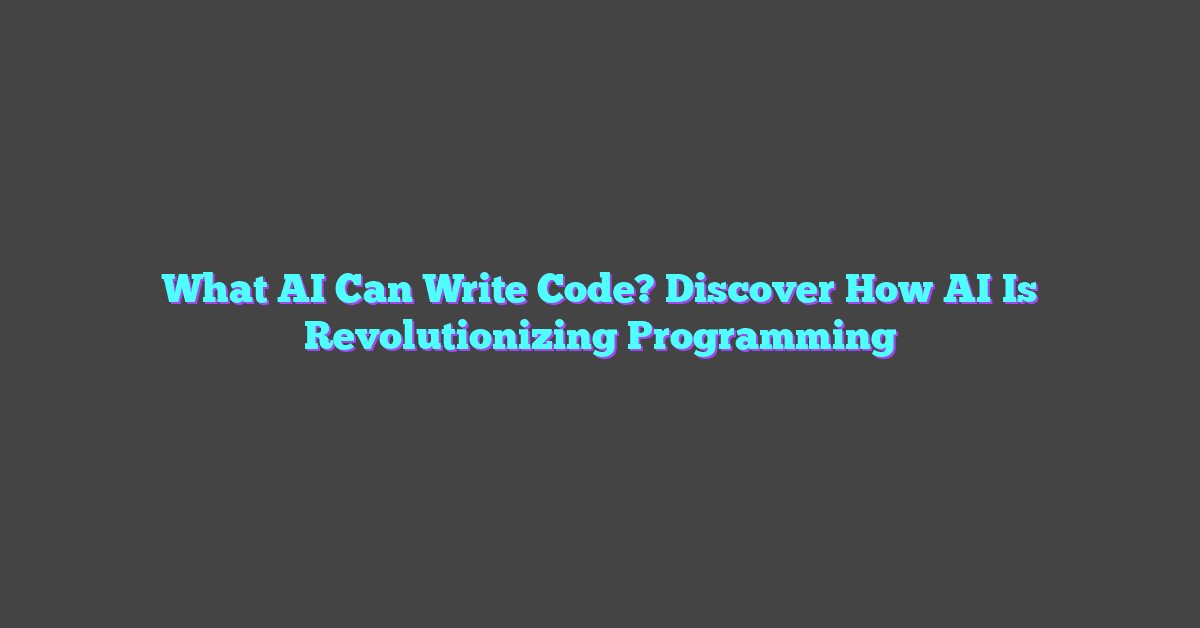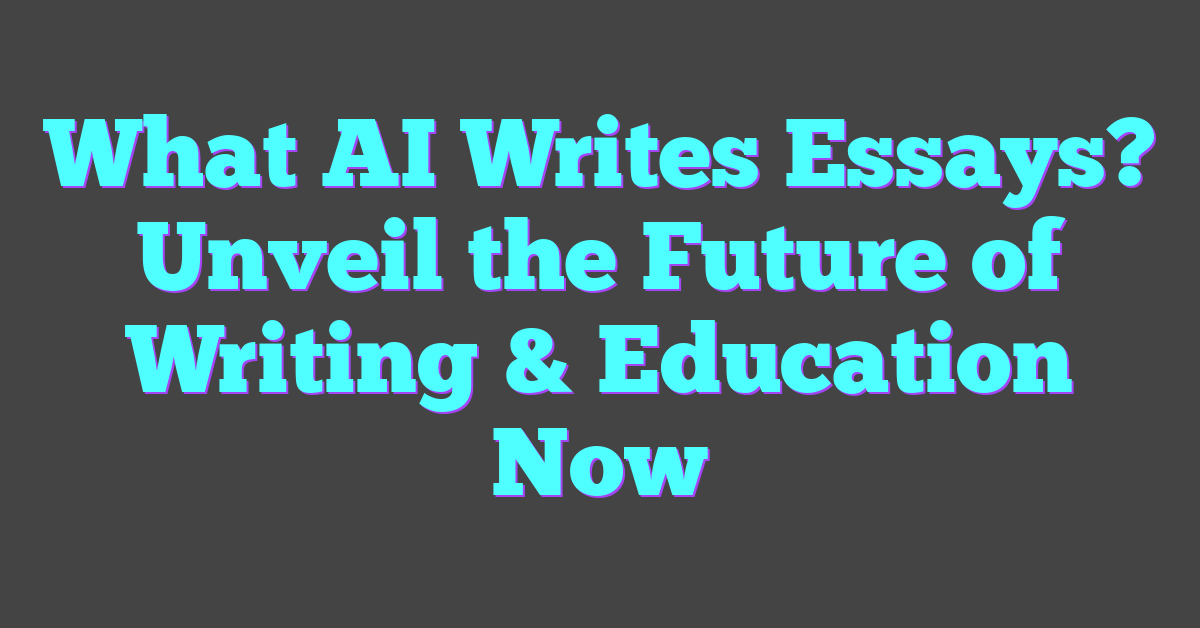Imagine a world where stories are not just penned by humans but also crafted by artificial intelligence. That’s right, AI’s capabilities have soared beyond data crunching to delve into the creative realm of storytelling.
From conjuring up fantastical tales to drafting compelling news articles, AI is pushing the boundaries of what was once thought exclusively human territory. They’re not just stringing words together; they’re weaving narratives that resonate.
In this article, we’ll explore how AI manages to write stories and the implications of this technological marvel. Stick around to uncover the magic behind AI-authored narratives that might just capture your heart.
The Rise of AI in Storytelling
Artificial Intelligence has experienced a dramatic rise in its capacity to influence the creative industry, particularly in the realm of storytelling. Storytelling, once the sole province of humans, has welcomed AI as its newest bard.
AI-driven storytelling tools leverage complex algorithms and data sets to generate narratives that are surprisingly coherent and emotionally resonant. They analyze vast amounts of literary content to learn story structures, character development, and linguistic styles. By identifying common patterns in successful stories, these tools can produce original content that captivates readers.
Taking it a step further, AI in storytelling isn’t just about emulating human writers. These systems introduce new capabilities that were previously unthinkable. For example, they can:
- Generate hundreds of story variations in a matter of seconds
- Customize stories based on reader preferences or feedback
- Translate narratives into multiple languages with ease
The fusion of AI and storytelling has led to the creation of interactive and adaptive stories, where the plot can evolve based on reader choices, similar to a choose-your-own-adventure book but with limitless branching paths.
Despite the fears that AI might one day replace human storytellers, this technology is largely seen as a tool for augmentation. It can take care of the more tedious aspects of writing, such as grammar checks and style consistency, which frees up human writers to focus on the imaginative and creative components of storytelling. Writers can then experiment with new formats and narrative devices, pushing the boundaries of traditional storytelling.
Moreover, AI’s involvement in storytelling has opened the doors for non-traditional voices to be heard. People who may not have the means or skill to pen down their thoughts can now tell their stories with the aid of AI, making the art form more inclusive. It’s an exciting time for storytellers, where the partnership between human creativity and machine efficiency is blossoming into new forms of narrative expression.
How Does AI Write Stories?
When delving into the mechanics of AI-driven story writing, one discovers a fascinating blend of technology and artistry. At its core, AI writing employs sophisticated algorithms that mimic human cognition to a degree. They start with a foundation in natural language processing (NLP) and machine learning, which enable computers to understand, interpret, and generate human language in a way that is both convincing and engaging.
These storytelling AIs are often fed a diet rich in literature: classics, modern works, genre-specific books, and even human-written story arcs. By digesting this extensive library, the AI learns various narrative structures, character development techniques, and the subtle nuances that give stories depth and flair. It’s the equivalent of an apprentice studying under a multitude of masters, absorbing their wisdom and styles.
To produce a new narrative, an AI typically undergoes several steps:
- Data Analysis: It mines its vast database for patterns, themes, and character archetypes.
- Plot Generation: The AI constructs a basic storyline, setting objectives and motives for its characters.
- Content Creation: Details are filled in – the who, what, when, where, and why of the story.
- Editing and Refinement: The AI reviews and revises the content to ensure coherence and emotional resonance.
This isn’t a one-way street. Human interaction plays a crucial role, with writers often setting parameters or providing prompts from which the AI crafts the story. They may specify genre, tone, or key plot points, allowing the AI to tailor the narrative accordingly.
The final stories generated by AI can be surprisingly diverse, offering everything from heartwarming tales to suspenseful adventures. These stories aren’t just strings of sentences but rather experiences crafted with intent; settings that feel lived-in, characters with ambitions, and plots that twist and turn with purpose.
The infusion of AI into storytelling is not about replacing human creativity but augmenting it, providing tools that can inspire and expand the bounds of what’s possible in narrative creation. In this way, AI is not the author of the story, but rather a collaborator, working alongside humans to weave tales in new and innovative ways.
Understanding Natural Language Processing
At the heart of AI-driven storytelling lies Natural Language Processing (NLP), an area of artificial intelligence that focuses on the interaction between computers and human language. It’s the technology enabling computers to understand, interpret, and generate human language in a way that is both meaningful and useful.
NLP combines computational linguistics—rule-based modeling of human language—with statistical, machine learning, and deep learning models. These models are used to process natural language data. The goal is not merely to understand words or phrases but to comprehend the entire context of the language a human would use.
To put it in simple terms, NLP allows an AI to “read” text by breaking down sentences into their constituent parts, identifying the role each word plays. For instance, it can distinguish between “rose” as a flower and “rose” as the past tense of “rise” based on context, which is no small feat for a machine.
The process of NLP typically involves several steps:
- Tokenization: Splitting the text into sentences, phrases, or words
- Part-of-Speech Tagging: Assigning parts of speech to each word, like noun, verb, adjective, etc.
- Named Entity Recognition: Identifying and categorizing key information in text, such as the names of people, organizations, locations
- Dependency Parsing: Analyzing the grammatical structure of a sentence, identifying relationships between “head” words and words which modify those heads
- Sentiment Analysis: Detecting the mood or subjective opinions within the text
- Language Generation: Taking structured information and translating it into human-readable text
The proficiency of an AI in storytelling largely hinges on its mastery of NLP, which arms it with the ability to emulate human-like language patterns. This proficiency is continually honed as the AI learns from more text input, gradually improving its narrative skills.
Incorporating NLP, AI writers can create intricate stories that resonate on a human level. These stories are not just strings of text but woven narratives made possible by understanding the intricacies of language. With each sentence crafted, the AI takes a step closer to bridging the gap between algorithmic output and heartfelt storytelling.
The Role of Machine Learning in Storytelling
Machine learning (ML), a pivotal component of AI, significantly enhances the capabilities of storytelling AI. At its core, ML uses algorithms to parse data, learn from it, and make predictions or decisions without being explicitly programmed to perform the task.
In the realm of storytelling, ML algorithms can identify patterns and nuances within vast datasets of text. This ability is not just about understanding individual words but also grasping the contextual relationships between them.
They train on different genres and styles, allowing them to adopt various narrative voices. For instance, a machine learning model exposed to works from Shakespeare might learn to craft tales with an Elizabethan flair. Similarly, digesting modern-day novels could enable the AI to produce stories that echo contemporary themes and language.
Key elements of storytelling such as plot development, character creation, and emotional arcs can also be better managed through machine learning methodologies. These models can develop complex characters with rich backstories and predict how these characters might interact or evolve within a story. The emotional trajectory of a narrative also benefits from ML, as systems can analyze and evoke sentiment effectively, ensuring that readers are engaged on an emotional level.
Data-driven insights assist in shaping narratives that are more aligned with readers’ preferences. Predictive analytics, a branch of ML, allows writers and publishers to understand what kind of stories are more likely to resonate with specific audiences, leading to more targeted and impactful storytelling.
Moreover, AI-driven tools assist writers by suggesting alternative plot lines or character developments, refining the creative process. Through iterative learning, AI and ML systems continuously improve, enabling them to assist authors in developing more cohesive and enthralling narratives over time.
As ML models become more sophisticated, the potential for AI to autonomously write compelling stories increases. Coupled with NLP, these technologies are poised to transform the art of storytelling, making it a blend of human creativity and machine efficiency.
Implications of AI-Authored Narratives
When AI applies its machine learning muscles to storytelling, the implications are profound not only for the written word but for the broader scope of creative arts. AI-authored narratives challenge our traditional notions of authorship and creativity. They invite us to question whether a story must originate from a human mind to be considered genuine or whether the orchestration of words by an algorithm can evoke the same emotional resonance.
These tales spun by machine intelligence impact the publishing industry and content creation in several meaningful ways. For one, they offer an abundance of content, perfectly tailored to reader preferences, identified through meticulous analysis of user data. Algorithmically generated stories can therefore be highly engaging, keeping readers hooked and driving them to seek out more AI-crafted content.
As AI continues to refine the narrative process, writers discover new forms of collaboration. They harness these tools to bypass writer’s block and enhance their creative flow, utilizing AI-generated suggestions to flesh out characters or propel plotlines forward. This partnership doesn’t replace the writer; instead, it augments their capabilities, allowing them to focus on the most impactful aspects of their stories.
Moreover, the entry of AI into the literary world democratizes storytelling. Novice writers who may lack the experience or confidence to construct complex narratives can lean on AI-driven platforms to scaffold their writing journey. This could lead to a surge in diverse voices and stories that might otherwise remain untold.
However, it’s essential to note the potential risks associated with AI narratives. The authenticity and originality of AI-generated content are subjects of debate. And there’s the concern of AI perpetuating biases present in the datasets it learns from, potentially leading to a homogenization of stories or the reinforcement of stereotypes.
Industry professionals are acutely aware that the integration of ML in storytelling is still in its infancy, which brings as much uncertainty as it does excitement. The impact on copyright laws, the need for transparency about AI’s role in creation, and how audiences perceive AI-authored works are evolving areas that require careful navigation.
With these developments, the future of AI in storytelling promises to be as riveting as the tales AI itself might one day pen.
Conclusion
AI’s foray into storytelling is reshaping the landscape of literature and content creation. As readers and writers alike navigate this new terrain, they’ll find opportunities for innovation and inclusion alongside challenges that must be addressed with care. The journey ahead is sure to be filled with stories as complex and captivating as those generated by the technology itself. With each narrative woven by artificial intelligence, the boundaries of imagination expand, promising a future where the art of storytelling can flourish in ways once thought impossible.
Frequently Asked Questions
Can AI truly create engaging stories?
AI has the capability to generate stories that are engaging and tailored to specific reader preferences, making it a powerful tool in crafting narratives that can captivate audiences.
How does AI influence content creators and writers?
AI tools aid content creators and writers by offering suggestions, helping them overcome writer’s block, and enhancing their creative processes through collaboration with the technology.
What impact does AI-authored content have on the publishing industry?
The advent of AI-authored content could lead to an increase in the volume and diversity of stories, democratizing storytelling and potentially disrupting the traditional publishing industry’s gatekeeping role.
Does AI-generated content pose authenticity or originality issues?
Yes, there are concerns that AI-generated content may lack authenticity or originality, as these stories are often derived from existing data, potentially echoing past works rather than introducing new, creative narratives.
Can AI perpetuate biases in storytelling?
AI has the potential to perpetuate biases found in the datasets it learns from, which could propagate stereotypes and narrow representations within AI-generated narratives unless addressed.
Are there copyright concerns regarding AI-generated stories?
The integration of AI into storytelling raises complex copyright issues that are still evolving, such as who holds the rights to AI-generated content and how existing copyright laws apply to such works.
Do readers know when a story is authored by AI?
Transparency about the role of AI in content creation is essential. It is important to disclose AI’s involvement so that readers are aware of the authorship of the stories they are engaging with.





